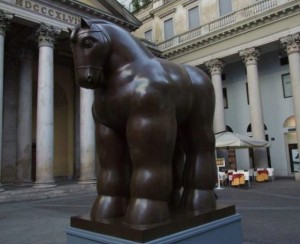 Cultures clash; they are clashing, as you can plainly see in the news. As long as they’ve bumped up against one another, they’ve clashed.
Cultures clash; they are clashing, as you can plainly see in the news. As long as they’ve bumped up against one another, they’ve clashed.
The differences—the causes of the clashes—are subject to endless debate, and rightfully so. Just as culture itself is a complex, multilayered concept, so too must be the mechanisms by which it causes conflict. So whether you believe that one given culture is reactionary and hypocritical about insults, and doesn’t understand the concept of free speech…or if you believe that another is repressive and condescending, and stirs up furor through calculated humiliation—either way there are equal chances you’re somewhat right, drastically oversimplifying or dangerously misunderstanding of the other side. Such is the nature of cultures trying to understand each other.
It’s complex enough that I can’t and won’t try to plumb those depths here. But another debate, one that doesn’t really offer any insights into or help with solving present events but is still fascinating, is how and why cultures got so combative in the first place. Why has violence, aptitude for and frequent expression of, settled just under the thin skin of civilization?
The usual answers: population pressures, food supply, territoriality, religion. Fair enough. You don’t need to be an historian to see how those have played out.
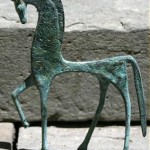 But casting backward a bit further, a bit closer toward the dawn of civilization in its many forms, there’s a somewhat more hidden cultural trigger I’d argue has always tilted societies toward the warlike. That’s the mastery of horse.
But casting backward a bit further, a bit closer toward the dawn of civilization in its many forms, there’s a somewhat more hidden cultural trigger I’d argue has always tilted societies toward the warlike. That’s the mastery of horse.
More peoples than not — at least in population numbers, if not distinct languages, norms, religions, etc. — have domesticated the horse. Horse was hardly the first domesticated animal anywhere; goats, sheep, pigs, and dogs almost always came first. But mastering horse was definitive, and transformative. That mastery brought all the obvious changes: extended range and quicker travel. It enabled more mobile armies and the first battle tactics beyond infantry slog. It brought horsepower to agriculture.
But through all that and more, horse mastery brought much else to culture. It brought metallurgy, or at least the first organized metal-working for purposes other than ceremonial. That new agriculture called for iron plow blades, and the wagons and chariots called for banded wheels. It’s a fact that cultures that grow up with no access to horses, the Australian and American natives primarily, never independently invent the wheel – or at best they never use it for anything but toys. No-horse cultures remain effectively stone-age level, unless and until they make contact with cultures that had mastered the horse.
Does that mean they’re less warlike? Not necessarily. They’re just as subject to the other factors, population pressures and the rest, as any culture. Clearly war, genocide, and all the rest have existed throughout the histories of the people of Australia and North and South America. But without horse, it was always that infantry slog. And it was in the service of countries with human-powered agriculture, that couldn’t afford for their men to be on the march for extended periods. War existed among these cultures, no doubt, but war for them was self-limited. By the lack of horse.
The rest of the world, the great horse-cultures of the Asian, African, and European continents, catapulted out of the stone age and into a still-ongoing march of technology — first grappling with technology related to their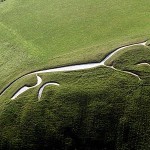 horse-driving endeavors, then later for all the things their horsepower enabled. This inevitably includes expansion, subjugation, and slaughter.
horse-driving endeavors, then later for all the things their horsepower enabled. This inevitably includes expansion, subjugation, and slaughter.
Ages later, the descendants of the horse-masters have moved beyond horse, far beyond it. But they’re still channeling that same drive, that conquering spirit, that cultural supremacy that was once spread from horseback.
The problem lies in those pesky numbers. Most civilizations were horse-masters, and all their descendants are elbowing up against each other now. Their ancestors rode in jihads and crusades, cossack charges and Mongol charges. They feel the modern version of that same pull toward the saddle, the drive to ride beyond the horizon carrying the banners of their people. They comprise the majority of the world’s population, at a time when there are few unclaimed horizons and the wrong banner can get you shot.
The hold-outs, the no-horses, have all but disappeared. A few of those cultures, like the Plains Indians, went through an accelerated version of horse mastery, after meeting up with horseback invaders, and did indeed make the horse the center of their lives. It happened in the space of a couple hundred years, instead of thousands. But that was still just a deviation, for the ultimate fate of the stone-age cultures in a horse-influenced world, is to be absorbed and to all but disappear.
Yet every now and then you hear of those uncontacted tribes, usually way up the Amazon somewhere, that are still hunting with bows and arrows and had not a notion of white people or airplanes or a world beyond the rain forest. Or of horses.
They don’t stand a chance. The world’s too small now for anyone to remain uncontacted, unabsorbed. At best they can hold out a while, or do-gooders can try to protect them for a while…but their fate as a people is sealed.
This all rings true, I think, but it doesn’t help much, does it? Knowing the earliest reasons your culture got out its knives doesn’t much point the way to putting them away. At best I’ve offered you a little cultural introspection.
But maybe you can get something from that. Maybe it can help you delve the reasons why you and your people thump your chests and throw your elbows. You and your people, and the horse you rode in on.
 The phone won’t stop ringing. Earlier in the cycle the calls were all from familiar voices, the candidates themselves or their smooth-talking celebrity surrogates. Here in the final push days, the types of calls are changing, getting more aggressive. They’re push-polling (“Wouldn’t you agree that That Other Guy is a flesh-clad demon, out to destroy us all?”), and trying to shame me into voting right now. Always all but suggesting that eschewing my hard-fought early-voting rights, that actually voting on election day, is somehow like not voting at all. Like letting the terrorists win.
The phone won’t stop ringing. Earlier in the cycle the calls were all from familiar voices, the candidates themselves or their smooth-talking celebrity surrogates. Here in the final push days, the types of calls are changing, getting more aggressive. They’re push-polling (“Wouldn’t you agree that That Other Guy is a flesh-clad demon, out to destroy us all?”), and trying to shame me into voting right now. Always all but suggesting that eschewing my hard-fought early-voting rights, that actually voting on election day, is somehow like not voting at all. Like letting the terrorists win. And why not? Our votes are more valuable than anyone else’s. Isn’t that what they’re telling us? Sure they’re drowning us in media, and that really does suck, but they’re also kissing every bit of our corn-fed Buckeye asses. And when I say “they” I’m talking about some of the most powerful men who walk the earth.
And why not? Our votes are more valuable than anyone else’s. Isn’t that what they’re telling us? Sure they’re drowning us in media, and that really does suck, but they’re also kissing every bit of our corn-fed Buckeye asses. And when I say “they” I’m talking about some of the most powerful men who walk the earth. hues, their votes are practically worthless next to mine. California, Texas, I’m looking at you. The candidates adore me, and they’ve no incentive at all to even acknowledge you.
hues, their votes are practically worthless next to mine. California, Texas, I’m looking at you. The candidates adore me, and they’ve no incentive at all to even acknowledge you. On any other day, if you’re asked that question, let the lessons of the
On any other day, if you’re asked that question, let the lessons of the 
 Surely you’ve some idea of your choices – with soda, with water, with ice, or with none of that. There’s no final answer. Or rather the answer can only be: drink it as you like it.
Surely you’ve some idea of your choices – with soda, with water, with ice, or with none of that. There’s no final answer. Or rather the answer can only be: drink it as you like it.








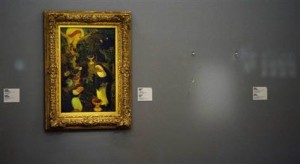
 If history is any indication, the paintings will either disappear into private collections, or will be held surreptiously for an indeterminate time before being
If history is any indication, the paintings will either disappear into private collections, or will be held surreptiously for an indeterminate time before being 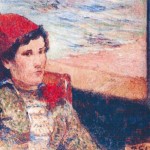 Stay tuned. Something tells me there’ll be more drama to follow in this developing story.
Stay tuned. Something tells me there’ll be more drama to follow in this developing story. With this week’s announcement of the award of the Nobel Prize for Literature, the world’s cultural attention has turned to Chinese literature. China has one of the world’s most ancient traditions of written art, yet has been mostly ignored by the Nobel committee until now. The award of the 2012 literature prize to author
With this week’s announcement of the award of the Nobel Prize for Literature, the world’s cultural attention has turned to Chinese literature. China has one of the world’s most ancient traditions of written art, yet has been mostly ignored by the Nobel committee until now. The award of the 2012 literature prize to author  He was an artist recognized in his lifetime for uncommon talent, astonishing attention to detail, and a fascination with mythological subjects, which was aesthetically felicitous and appropriate for his Victorian upbringing.
He was an artist recognized in his lifetime for uncommon talent, astonishing attention to detail, and a fascination with mythological subjects, which was aesthetically felicitous and appropriate for his Victorian upbringing. touches on the revolutionary mid-19th century developments in the treatment of mental illness, for Richard Dadd was to be committed to the care of the first generation of physicians who recognized, and attempted to treat, diseases of the mind. This was a radical departure from even a decade or so earlier, when insanity was viewed as a moral failing, and treated with the utmost level of callousness and cruelty.
touches on the revolutionary mid-19th century developments in the treatment of mental illness, for Richard Dadd was to be committed to the care of the first generation of physicians who recognized, and attempted to treat, diseases of the mind. This was a radical departure from even a decade or so earlier, when insanity was viewed as a moral failing, and treated with the utmost level of callousness and cruelty. accepted into the Royal Academy of Arts at an early age. His fabulous depictions of fairies and other popular supernatural motifs began receiving attention and renown, and he gained lucrative commissions for the illustration of fairy-tale books and magazines.
accepted into the Royal Academy of Arts at an early age. His fabulous depictions of fairies and other popular supernatural motifs began receiving attention and renown, and he gained lucrative commissions for the illustration of fairy-tale books and magazines. to the newly created
to the newly created 

 Cultures clash; they are clashing, as you can plainly see
Cultures clash; they are clashing, as you can plainly see  But casting backward a bit further, a bit closer toward the dawn of civilization in its many forms, there’s a somewhat more hidden cultural trigger I’d argue has always tilted societies toward the warlike. That’s the mastery of horse.
But casting backward a bit further, a bit closer toward the dawn of civilization in its many forms, there’s a somewhat more hidden cultural trigger I’d argue has always tilted societies toward the warlike. That’s the mastery of horse.
 At the intersection of politics and pop culture we find
At the intersection of politics and pop culture we find  days). Fairey says he was just experimenting with stencil-making, and happened to use a handy newspaper image of the outsized pro wrestler. Regardless, the image became insanely popular, particularly among skaters, and versions of it began appearing all along the East Coast. In 1994 Fairey was threatened with a copyright infringement suit by Vince McMahon’s
days). Fairey says he was just experimenting with stencil-making, and happened to use a handy newspaper image of the outsized pro wrestler. Regardless, the image became insanely popular, particularly among skaters, and versions of it began appearing all along the East Coast. In 1994 Fairey was threatened with a copyright infringement suit by Vince McMahon’s  Titan Sports, which spurred him to change the image, ever so slightly. The “
Titan Sports, which spurred him to change the image, ever so slightly. The “
 Circumstances have brought us to an odd place, where we can simultaneously consider the horrors of an old war, one that’s a hundred years gone and that was supposed to end all wars, and also our grim present, in the form of an unfolding environmental calamity.
Circumstances have brought us to an odd place, where we can simultaneously consider the horrors of an old war, one that’s a hundred years gone and that was supposed to end all wars, and also our grim present, in the form of an unfolding environmental calamity.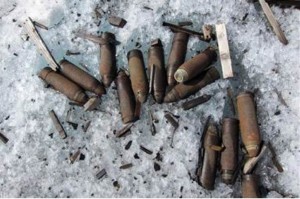 ammo casings, and every other kind of battle detritus have emerged into sunlight, probably for the first time since shortly after the fighting in which they were used.
ammo casings, and every other kind of battle detritus have emerged into sunlight, probably for the first time since shortly after the fighting in which they were used.